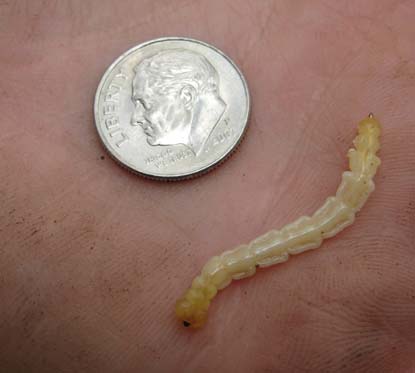|

Contact: John Perez, 304-465-6537 “National Park Service biologists have confirmed the presence of an exotic forest pest known as the emerald ash borer,” announced Don Striker, Superintendent of New River Gorge National River (NRGNR). “This shiny green beetle was found in ash trees adjacent the park boundary near Minden, in Fayette County, which is the first documented infestation in West Virginia.” According to Park Biologist John Perez, the insect is well known to residents of Michigan, Ohio, and Indiana, where it has already killed more than 20 million trees. “Native ash trees have little natural defense against this borer. All of West Virginia’s ash trees are at risk – they face the same fate as the American chestnut and American elm which were defenseless against the chestnut blight and Dutch elm disease,” explained Perez. The emerald ash borer was first discovered near Detroit, Michigan about 10 years ago, and probably came to America inside the wood of a packing crate from China. The insect is now threatening 7.5 billion ash trees growing in 40 states. In a recent Ohio study, the economic loss of ash trees was estimated between $1.8 and $7.6 billion. In West Virginia where forests cover 76% of the state, total losses including ash timber products, nursery stocks, and the costs of landscaping removals and replacements are estimated at over $1 billion dollars. “Maryland, Ohio and Michigan have fought the pest aggressively by implementing eradication efforts, which included the collection and destruction of all ash trees within a ½ mile radius of a known infestation,” noted Perez. “This massive program was labor intensive and extremely expensive. Eradication efforts have generally proven ineffective, because the pest is difficult to detect, can fly up to 20 miles, and is easily transported in contaminated wood products, especially firewood.” Superintendent Striker also said “the National Park Service (NPS) is considering a range of alternatives to combat this pest. In January 2008, a Federal and State Quarantine was enacted which prohibits the movement of all hardwood firewood out of Fayette County, West Virginia, and it is also against NPS regulations to take firewood out of the park. Now, the NPS has also instituted a ban on bringing firewood into the park.” “Because humans unknowingly contribute to the spread of emerald ash borer when they move firewood, it is important that campers REFRAIN FROM BRINGING CAMPFIRE WOOD INTO THE PARK,” he emphasized. “Whenever possible, utilize alternative sources of fuel, or only burn dead and down wood that is found near your campsite.” For more information on EAB, contact John Perez at 304-465-6537, or visit the EAB Pest Alert website at: https://www.na.fs.fed.us/spfo/pubs/pest_al/eab/eab04.htm Additional information: New River Gorge National River (NRGNR) contains some of the best examples of bottomland forest in the mid-Atlantic, where ash trees can comprise up to 20% of the forest canopy and grow to over 100 feet in height. Ashes make wonderful shade trees and are frequently planted along roadways and in residential landscapes. They are also well known for their brilliant fall colors. Ash trees are common along stream corridors and in the deep coves of NRGNR. Approximately 34,000 acres of the park’s forest are comprised of greater than 10% ash species and 466 acres have nearly 20% ash composition. The park stands to lose well over a million trees with the greatest visual impacts being along the river. Beyond the boundaries of the park, ash is an important commercial hardwood, and its tough wood is used in variety of products such as furniture, cabinetry, flooring, paneling, and tool handles. American ash is also used in the production of baseball bats used by most major league players. |
Last updated: February 26, 2015
